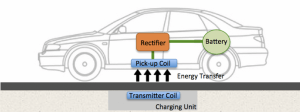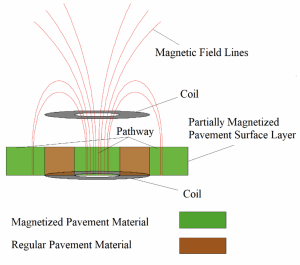
An illustration of the wireless charging process through electrified pavement.
An innovative, electrified-pavement design created by Rutgers researchers can enable efficient Electric-Vehicle charging and has the potential to help transform roadways into sustainable energy sources in the future.
As federal investment grows in Electric Vehicles (EVs) and they begin to replace conventional transportation methods, having the right infrastructure in place to ensure efficient EV charging will become critical to support the growing fleet of electric cars, trucks, and buses on our roads.
One promising solution is implementing wireless-charging techniques directly into existing roadway pavements, said Hao Wang, an associate professor in the Department of Civil and Environmental Engineering at Rutgers University. An Electrified Road (eRoad) can provide a continuous power supply for EVs while maintaining the vehicle’s mobility.
In a recent research project, he developed an innovative design of partially magnetized pavement that was able to improve wireless-charging efficiency from the roadway directly to electric vehicles while still remaining durable enough to support heavy traffic volumes.
“Electrified pavements can provide a sustainable power supply for electric vehicles,” Wang said. “However, the complicated structure design needed for wireless charging often comes at the expense of pavement service life. In this project we developed a new, partially magnetized pavement design that uses the existing infrastructure to maintain its durability while also providing more efficient charging for EVs.”
The study shows that the partially magnetized pavement design provided a 1.5% to 13.3% charging efficiency improvement compared to conventional pavements for wireless charging.

The design concept for the partially magnetized pavement layer that was developed.
It works by creating a magnetized pathway through the traditional pavement layer that can better guide and connect magnetic fields between the pavement transmitter and the EV receiver coils, Wang said.
The research stems from a Rutgers CAIT University Transportation Center (UTC) project, “Durable and Electrified Pavement for Dynamic Wireless Charging of Electric Vehicles.” It was recently featured in TRB Weekly’s “Research Roundup” for the week of October 25th.
A topic of focus under recent federal legislation, investment in electric transportation brings with it significant benefits in supporting clean energy, environmental sustainability, and reducing emissions. As part of the Bipartisan Infrastructure Law, $7.5 billion will be invested into building a national network of 500,000 EV chargers across the United States.
The investment has the potential to accelerate the adoption of EVs, reduce emissions, improve air quality, and create good-paying jobs across the country. In order to achieve these goals, efficient charging infrastructure is still needed to help overcome EV limitations such as battery capacity, high initial cost, and short range, Wang said.
“Electrified pavements and dynamic charging infrastructure can greatly support the growth and adoption of electric vehicles,” he said. “These technologies can also help increase the sustainability, connectedness, automation, and intelligence of our transportation systems.”
The results of this study were also previously published in Energy Conversion and Management, a high-impact journal.

